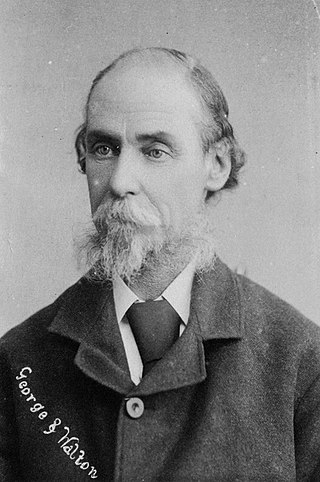John Lazar was an actor and theatre manager in Australia. He was Mayor of Adelaide from 1855 to 1858.
Peacock & Son was a tanning and wool-brokering business in the early days of South Australia. Three members of the family were notable public figures: William Peacock was a successful businessman and one of the colony's first parliamentarians. His eldest son Joseph Peacock carried on the family business and was a member of parliament. His youngest son Caleb Peacock was a member of parliament and Mayor of Adelaide from 1875 to 1877, the first such born in the Colony.
G. H. Michell and Sons was an Australian wool processing and broking company based in Hindmarsh, South Australia, relocated to Salisbury, South Australia and with a change in company structure in the 1980s became Michell Australia Pty Ltd then the Michell Group of Companies.

The Bunyip is a weekly newspaper, first printed on 5 September 1863, and originally published and printed in Gawler, South Australia. Its distribution area includes the Gawler, Barossa, Light, Playford, and Adelaide Plains areas. Along with The Murray Pioneer, The River News, and The Loxton News,The Bunyip was now owned by the Taylor Group of Newspapers and printed in Renmark.
William Smallpeice Whitington was an early English settler in South Australia, founder of the shipping company Whitington & Co. He emigrated on his own ship New Holland, arriving in South Australia in July 1840. That cargo, which made for him a tidy profit, included Falklandina and Actaeon, the colony's first thoroughbred mare and stallion, the basis of John Baker's racing stud. He brought in South Australia's first steamers: Corsair and Courier, and the brig Enterprise for trading between the colony's ports. The ships went into service just as overland routes were opening up, and proved a costly mistake. He later invested in a number of mining ventures, at a substantial loss. His descendants included a number of notable individuals.
William Hampden Dutton, generally known as Hampden Dutton, was a pioneering pastoralist in New South Wales and South Australia.
Charles Birks & Co Ltd. was a South Australian department store founded by Charles Napier Birks in Rundle Street, Adelaide. His son Napier Birks took over the business in 1908. The business was acquired by David Jones Limited in 1954.
Violet May Plummer, BSc., ChB, MB. was a South Australian medical doctor, one of the first women from the University of Adelaide to graduate in medicine, [the first was Laura Margaret Hope née Fowler] and in 1900 was the first woman General Practitioner to practise in Adelaide.
D. & W. Murray was a drapers shop in Adelaide founded by brothers David Murray and William Mackintosh Murray, which became the wholesale draper D. & W. Murray Limited, with warehouses in three States, then Goode, Durrant & Murray second in importance only to G. & R. Wills.
Thomas Good was a merchant of Adelaide, South Australia, a founder of the wholesale drapery business of Good, Toms & Co.
John Legoe was a ship's captain, associated with the sailing ships Celestial, The Murray, Yatala and Hesperus, before settling in South Australia, where he and his family were notable citizens.

Hesperus was an iron-hulled, three-masted, passenger clipper ship that was built in Scotland in 1874 and scrapped in Italy in 1923. She was built for Thompson and Anderson's Orient Line service between Great Britain and South Australia.
James Pile was a South Australian pastoralist who had extensive holdings on the Darling River in New South Wales, and succeeded by his sons William, John and Charles, collectively known as the Pile brothers.

George Ettienne Loyau was an English-born traveller, poet and historian in Australia, best known as the author and editor of Notable South Australians.
Arthur William Jarrett was a pioneer radio broadcaster in South Australia.
The Hindmarsh Brewery was a brewery founded c.1844 in Hindmarsh, in the then colony of South Australia, by E. J. F. "Fred" Crawford. Crawford lost possession of the business in 1859, then re-established it on a different site before becoming bankrupt. It was then taken over by Henry Haussen and George Catchlove, and was successfully operated by them and their successors until 1927.
Henry Jackson Moseley was a builder and publican in the very early days of the British colony of South Australia.
John James Bonnar was a schoolteacher and lawyer in the early days of the colony of South Australia.
Sydney Thomas Charles Best was a long serving Anglican priest in South Australia.
Albert Edwin "Bert" Hamilton (1873–1962) was a South Australian public accountant who had a significant involvement with several major institutions.